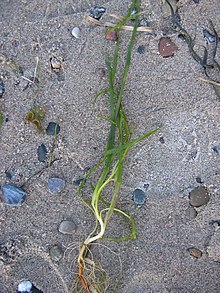Zostera marina
| Zostera marina | |
|---|---|
 | |
| Conservation status | |
| Scientific classification | |
| Kingdom: | Plantae |
| (unranked): | Angiosperms |
| (unranked): | Monocots |
| Order: | Alismatales |
| Family: | Zosteraceae |
| Genus: | Zostera |
| Species: | Z. marina |
| Binomial name | |
| Zostera marina L. | |
Zostera marina is a species of seagrass known by the common names common eelgrass and seawrack. It is an aquatic plant native to marine environments on the coastlines of mostly northern sections of North America and Eurasia. It is the most wide-ranging marine flowering plant in the Northern Hemisphere. It lives in cooler ocean waters in the North Atlantic and North Pacific, and in the warmer southern parts of its range it dies off during warmer seasons. It grows in the Arctic region and endures several months of ice cover per year. It is the only seagrass known from Iceland. It can be found in bays, lagoons, estuaries, on beaches, and in other coastal habitat. It occurs in calmer waters in the sublittoral zone where it is rarely exposed to air. It anchors via rhizome in sandy or muddy substrates and its leaves catch particulate debris in the water which then collects around the bases of the plants, building up the top layer of the seabed.
This flowering plant is a rhizomatous herb which produces a long stem with hairlike green leaves that measure up to 1.2 centimeters wide and may reach over a meter long. It is a perennial plant but it may grow as an annual. The rhizome grows horizontally through the substrate, anchoring via clusters of roots at nodes. The plant is monoecious, with an individual bearing both male and female flowers in separate alternating clusters. The fruit is a nutlet with a transparent coat containing the seed. The plant can also undergo vegetative reproduction, sprouting repeatedly from its rhizome and spreading into a meadowlike colony on the seabed known as a genet. One meadow of cloned eelgrass was determined to be 3000 years old, genetically. When undergoing sexual reproduction, the plant produces large quantities of seeds, at times numbering several thousand seeds per square meter of plants. The plant disperses large distances when its stems break away and carry the fertile seeds to new areas, eventually dropping to the seabed. The seagrass is a favorite food of several species of waterfowl, which may also distribute the seeds.
This plant is an important member of the coastal ecosystem in many areas because it helps to physically form the habitat and it plays a crucial role for many other species. For example, it provides a sheltered spawning ground for the Pacific herring (Clupea pallasii). Baby Atlantic cod (Gadus morhua) hide in eelgrass beds as they grow. The Blue mussel (Mytilus edulis) attaches to its leaves. The green alga , an endophyte, depends on this eelgrass. A great many animals use the plant for food, including the isopod and the purple sea urchin Paracentrotus lividus. The Atlantic Brant (Branta bernicula hrota) subsists almost entirely on the plant. When the eelgrass dies, detaches, and washes up on the beach a whole new ecosystem is founded; many species of insects and other invertebrates begin to inhabit the dead plant, including the amphipod Talitrus saltator, the fly , and the beetles , , and Coccinella septempunctata.
Populations of the plant have been damaged by a number of processes, especially increased turbidity in the water; like most other plants, eelgrass requires sunlight to grow. One plant may adapt to light level by growing longer leaves to reach the sun in low-light areas; individuals in clear or shallow water may have leaves a few centimeters long, while individuals in deeper spots may have leaves over a meter long. Human activities such as dredging and trawling damage eelgrass meadows; practices used in scallop and mussel harvesting in the Wadden Sea have cleared much eelgrass from the sea bottom there. Aquaculture operations and coastal development destroy colonies. Pollution from many sources, including riverside farms, sewage lines, fish processing plants, and oil spills damage eelgrass meadows.
Invasive species have been shown to have a negative effect on eelgrass and associated ecosystems. In Nova Scotia the invasive exotic green crab (Carcinus maenas) destroys eelgrass when it digs in the substrate for prey items. The decline of eelgrass in Antigonish Harbour has resulted in fewer Canada Geese, which feed on the rhizome, and fewer Common Goldeneye, which eat invertebrates that live in eelgrass meadows.
The slime mold caused a "wasting disease" of eelgrass resulting in large-scale losses in the 1930s; localized populations are still affected by the slime mold today. During this time, populations of the eelgrass-eating Atlantic Brant dropped. Remaining geese ate less-preferred food plants and algae and hunters subsequently noticed that Brant meat began to taste different. Even today Brants no longer migrate over the Nova Scotia area.
People have long used this plant species as roof thatching in some areas. It has been used as fertilizer and cattle fodder in Norway for centuries. It could also be dried and used as stuffing for mattresses and furniture.
The bacterial species was first isolated from the leaves of the plant.
References
External links
Retrieved from : http://en.wikipedia.org/w/index.php?title=Zostera_marina&oldid=462159559
